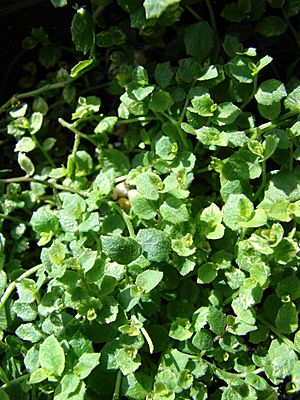Swamp isotome facts for kids
Quick facts for kids Swamp isotome |
|
|---|---|
 |
|
| Isotoma fluviatilis folige and flowers | |
| Scientific classification | |
| Genus: |
Isotoma
|
| Species: |
fluviatilis
|
| Synonyms | |
|
Laurentia fluviatilis (R.Br.) E.Wimm |
|
The Swamp Isotome, also called the Blue Star Creeper, is a small plant that lives for many years. Its scientific name is 'Isotoma fluviatilis'. It belongs to the Campanulaceae plant family.
Contents
What Does It Look Like?
This plant is a low-growing herb. It often spreads out to form a soft, green mat on the ground. It can have tiny hairs (pubescent) or be smooth (glabrous). It also grows roots from its stems, which helps it spread.
Its leaves are a deep green color. They are usually about 4 to 12 millimeters long. They are also about 2 to 8 millimeters wide. The leaves can be different shapes, like oval, long and narrow, or egg-shaped.
Flowers and Seeds
The Swamp Isotome grows pretty white flowers. Each flower grows by itself from the stem. These flowers can have both male and female parts, or sometimes just one kind.
After the flowers bloom, small seed pods form. These pods are shaped like a cone or an upside-down egg. They are usually about 3 to 6 millimeters long. They are also about 3 millimeters wide.
The plant blooms during the summer, from November to March. It creates a beautiful carpet of white-blue, star-shaped flowers. Each flower has five petals. This makes it a great plant for gardens, especially as a groundcover. You can find it in rock gardens or between paving stones.
How It Was Named
This plant was first described by a botanist named Robert Brown in 1810. He first called it Lobelia fluviatilis. Later, in 1864, another botanist named George Bentham reclassified it. He moved it into the genus Isotoma.
Some other names have been used for this plant over time. These include Laurentia fluviatilis, Enchysia gaudichaudii, and Rapuntium fluviatile.
Different Types of Swamp Isotome
There are three known types, or subspecies, of the Swamp Isotome:
- Isotoma fluviatilis subsp. australis
- Isotoma fluviatilis subsp. borealis
- Isotoma fluviatilis subsp. fluviatilis
Where Does It Grow?
The Swamp Isotome likes to grow in wet places. You can often find it in moist sand or mud. It grows along the edges of creeks and streams. It also likes areas where water seeps out of the ground. Sometimes, it grows among granite rocks or in wet dips in the land.
This plant is found in southeastern Australia. It grows in the southern parts of South Australia. It also spreads through most of Victoria and Tasmania. You can also find it in eastern New South Wales and southeastern Queensland.


